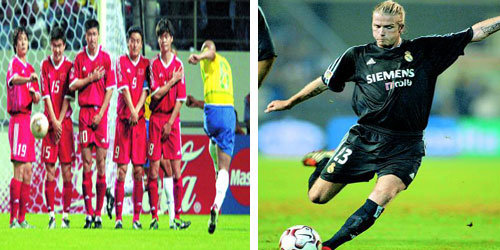Shot Artists Make Goalmaking a Science
Shot Artists Make Goalmaking a Science
Posted April. 29, 2006 06:36,

Soccer is about kicks. The brief impact from the players foot sends the ball flying in various lines of movement. Soccer fans all over the world witnessed Roberto Carloss flying saucer kick on June 4, 1997 at the Four Nations Invitational in France. At the France versus Brazil match, Carlos kicked a ball that literally took a roundabout course to bypass a wall of opposing defenders and landed in the net. Soccer fans all over the globe expect to feast their eyes on some amazing goals like this in the upcoming World Cup.
Italys Pirlo and Brazils Juninho have shown the world a fantastic kick that puts high velocity and zero spin on the ball. Up until recently, free kick masters preferred to kick the ball with either the inside or outside of their feet. Such a kick sends the ball spinning very fast and curving near the goalpost. These kicks are usually aimed at the upper corner of the goal where goalies have most trouble covering.
But the high speed and non-spun ball sometimes flies directly into the goalie. It has the same characteristics as a knuckleball: the ball does not spin but vibrates heavily. Sometimes the ball gyrates right in front of the goalkeeper or drops suddenly. The unpredictable movement of the ball flusters goalies.
To launch such a ball, the impact has to be made at the dead center of the ball. Italys Andrea Pirlo and Brazils free kick wizard Juninho are the two that have most success with their free kicks in this fashion. Portuguese soccer star Christiano Ronaldo has attempted it as well. Pirlo shares that the trick lies in having the proper stance. Contact must be made at the center of the ball using only three toes, Pirlo explained.
The 108km/h flying saucer kick may have made a comeback. The curving movement of a soccer ball can be explained by physics laws such as Bernoullis Theorem and the Magnus effect. When a soccer ball spins, the air pressure surrounding the ball changes, and the ball moves to the side where the air flows faster. Physically speaking, Carloss free kick is estimated to have been revolving 10 times per second and traveling 108km/h. To put such movement on a ball, the ball needs to be kicked hard and strong spin must be applied.
The only problem is that it is difficult to make a fast moving ball when you are putting a lot of spin on it. If a kicker wants to send a spinning ball traveling at 108km/h, he must at least be capable of making a normal kick that travels 135km/h. On national level, Korea has players who can kick the ball at around 130km/h. Theoretically, those players are capable of imitating Carloss kick.
A free kick requires precision. Masters of free kick such as David Beckham of England have higher success rates 23 to 33 meters away from the goal. The time it takes for his ball to reach the goal line is about 0.70 to 0.95 seconds. The average velocity of his ball is about 118 to 125km/h. For a precise free kick, the targeted spot on the ball and your foot must meet within an error margin of two centimeters. It is also important to make precise contact with the balls sweet spot where only the foot gets the feedback and no vibration occurs on the entire leg upon impact.
Won-Hong Lee bluesky@donga.com



![“국힘 41% 득표가 졌잘싸? 되레 독 될수도”[정치를 부탁해]](https://dimg.donga.com/c/138/175/90/1/wps/NEWS/IMAGE/2025/06/04/131745994.1.jpg)



